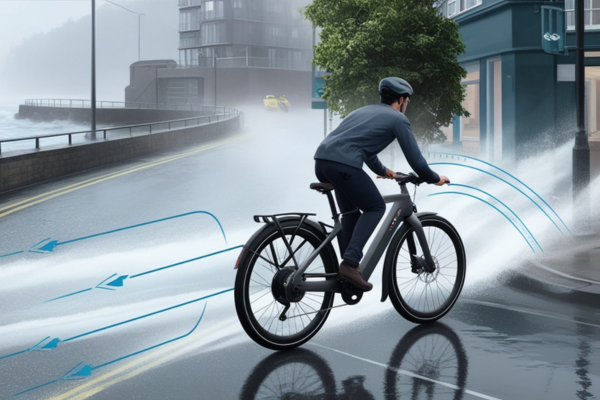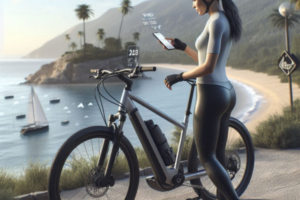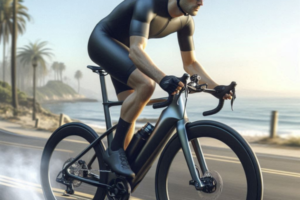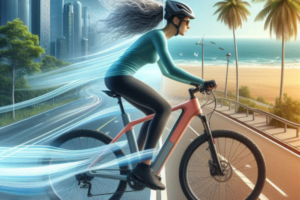When riding an electric bicycle in coastal or tropical environments, humidity becomes a constant presence. Most riders are aware of how heat or wind can impact their experience—but few stop to consider how humidity might affect something as fundamental as wind resistance and overall performance. This article dives deep into how humid air interacts with aerodynamic drag, moisture retention, and bike efficiency in real-world coastal riding conditions.
🌫️ The Physics of Humid Air: Is It Heavier or Lighter?
One of the most misunderstood facts in physics is that humid air is actually less dense than dry air. Although it might seem counterintuitive—since humidity adds water to the air—the molecular weight of water vapor (H2O) is lower than that of the average molecules in dry air (mainly nitrogen and oxygen). The result? Humid air offers slightly less aerodynamic drag than dry air, which can theoretically benefit e-bike speed and energy efficiency.
However, in practice, this benefit is marginal. The difference in air density between 0% and 100% relative humidity at the same temperature is around 1.1%—not enough to dramatically affect your ride on its own. Still, when combined with other environmental variables, the effect becomes part of a broader performance equation.
💦 Real-World Impacts: Humidity and Aerodynamics
In humid environments, the more noticeable impact on wind resistance comes not from the air density but from how moisture affects the rider and the bicycle directly. Sweat-soaked clothing, fogged visors, and condensation on the bike frame all contribute to minor aerodynamic inefficiencies. More significantly, added moisture can:
- Increase the overall surface area of drag on the rider due to loose or soaked fabrics
- Add weight to clothing and gear, affecting rolling resistance
- Decrease ventilation efficiency in helmets and jackets, leading to overheating
🔧 Moisture and Mechanical Resistance
While aerodynamic drag is influenced by air density and body posture, mechanical resistance is often the silent thief of performance in humid climates. Wet roads combined with humid air lead to a higher likelihood of:
- Rust on the drivetrain and chain, increasing friction
- Swollen bearing seals or degraded greases
- Reduced tire pressure due to temperature-humidity interactions
Routine maintenance becomes even more critical. As Florida E-Bikes notes, regularly cleaning and drying components, lubricating chains with moisture-resistant products, and inspecting electrical connections can prevent performance losses in high humidity.
📊 Comparing Dry vs. Humid Coastal Rides
| Factor | Dry Coastal Ride | Humid Coastal Ride |
|---|---|---|
| Air Density | Slightly Higher | Slightly Lower |
| Drag Resistance | Higher | Marginally Lower |
| Moisture on Gear | Minimal | Noticeable |
| Rust Risk | Low | High |
| Clothing Efficiency | Stable | Reduced (if soaked) |
🧥 Apparel and Gear Tips for Humid Conditions
Choosing the right apparel can make or break your ride in humid areas. Look for technical fabrics that dry quickly and resist absorbing water. Avoid cotton or heavy blends. Instead, use cycling wear with mesh panels, sweat-wicking properties, and antimicrobial coatings. Helmets with wide ventilation channels and anti-fog visors can also enhance both comfort and safety in moist air.
🚿 The Hidden Aerodynamic Penalty of Sweat
On long rides, especially during summer or in tropical zones, the rider becomes a source of moisture as well. Wet clothing that clings irregularly can disrupt laminar airflow. So can heavy perspiration that saturates your shirt or shorts. Carrying an extra shirt or using ventilated outer layers can help keep airflow smooth around your body. Even the choice of gloves and socks can influence how insulated or slippery you feel in motion.
🔌 Electronics and Humidity: Protecting Your Investment
Your e-bike’s electronic components, such as the battery, display, and sensors, can be affected by prolonged humidity. While most systems are sealed, salt-laden humid air can still creep into charging ports or control buttons. Use silicone covers, park your bike in shaded areas, and wipe down interfaces after each ride. These simple habits help preserve performance and safety.
🌬️ Wind Perception in Humid Conditions
Interestingly, riders often report that wind “feels stronger” in humid conditions. While the actual force of wind may be the same, the combination of moisture in the air and sweating skin can lead to a perception of heavier airflow. This psychological effect is especially common in riders transitioning from dry inland areas to tropical coastal regions. Helmet fit, visor fogging, and even how clothing clings to the body can intensify this sensation.
🚴♂️ Coastal Cities and Humid Riding Experiences
Let’s consider a few scenarios drawn from common experiences of riders in humid coastal cities:
- Tropical urban commuters often face unexpected morning condensation that affects battery terminals and controller displays.
- Recreational riders in island regions report a need to reapply anti-corrosion sprays weekly due to salt-rich air combined with high humidity.
- Delivery cyclists near ports often switch to thinner clothing and frame-mounted waterproof bags to maintain agility and avoid water saturation.
These are not isolated anecdotes—they reflect regional patterns in rider adaptation and gear evolution.
🧼 Anti-Corrosion and Cleaning Practices
Humidity doesn’t only increase drag—it accelerates wear and tear. To protect your e-bike in humid zones:
- Wipe your bike dry after every ride, especially near electrical contacts.
- Apply dielectric grease to connectors and terminals to resist moisture intrusion.
- Use anti-corrosion sprays on bolts, drivetrain, and bottom bracket.
- Store the e-bike indoors or under UV-resistant covers.
- Schedule deep cleaning at least twice a month if riding daily.
👕 Clothing Technologies That Support Aerodynamics
Modern sportswear offers humidity-adapted features that support airflow and minimize moisture drag. Look for fabrics with:
- Laser-cut ventilation zones
- Anti-stick inner linings
- Hydrophobic surface coatings
- Compression fit for upper body areas to reduce flapping
Footwear also plays a role—breathable mesh shoes dry faster, keeping your body cooler and reducing the total system load.
📋 Humidity Ride Preparation Checklist
- ✔️ Check weather apps for humidity % and dew point before departure
- ✔️ Dress in moisture-wicking and UV-rated garments
- ✔️ Carry a microfiber cloth for wiping down visors or displays mid-ride
- ✔️ Inflate tires to ideal pressure based on ambient temperature
- ✔️ Apply lubricant suitable for wet or tropical conditions
- ✔️ Use waterproof storage for electronics and tools
📉 Common Humidity-Related Performance Issues
| Problem | Cause | Preventive Action |
|---|---|---|
| Reduced range | Added moisture weight, rolling resistance | Dry gear, adjust pressure, clean drivetrain |
| Sensor errors | Condensation in wiring | Use sealed connectors and dry bike after ride |
| Frame corrosion | Salt and moisture buildup | Apply anti-corrosion coating and rinse regularly |
| Fogged visor or glasses | Poor ventilation + sweat | Anti-fog spray or wipe, choose ventilated models |
💬 Final Thoughts
Humidity may seem like a subtle environmental factor, but its impact on electric bicycle performance is multifaceted. From aerodynamic perception and drag to corrosion and sensor reliability, riding in a humid coastal city presents unique challenges—and opportunities. By understanding how moisture interacts with airflow and your gear, you can make smart adjustments that keep your ride smooth, efficient, and enjoyable year-round.
Whether you’re gliding along Caribbean boardwalks or navigating a foggy portside commute, preparation is your best ally. Optimize your apparel, protect your components, and monitor your bike’s responsiveness over time. With the right habits, high humidity doesn’t have to mean high resistance.
💧 How do you handle humid rides? Share your tips with the community below! 🌊



